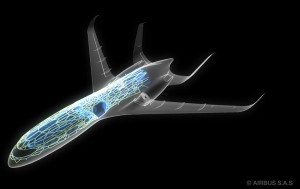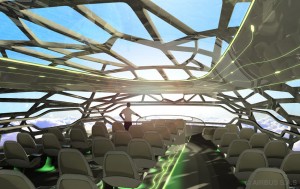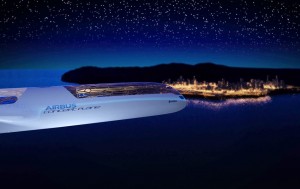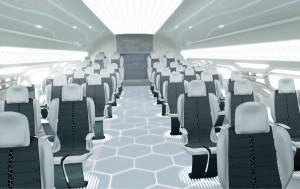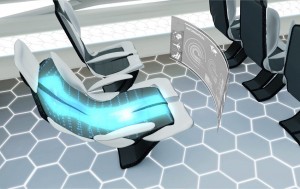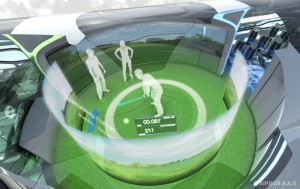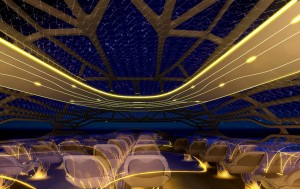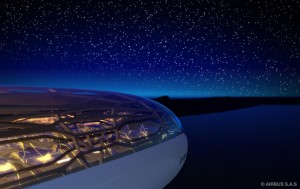Through innovation, and out-of-the-box thinking, Airbus continues to meet its eco-efficiency goals, and ensure that air travel continues to be one of the safest, and most eco-efficient, means of transportation.
In a new report, “The Future by Airbus,” Airbus looks forward to the year 2050 and beyond, and highlights the anticipated global needs of a better-connected and more sustainable world.
Future energy sources for Aviation:
Biofuels:
Traditionally, carbon based/kerosene-like fuels have proven to be the best energy carrier for aircraft, because of properties like their ability to maintain stable temperatures. Biofuels offer many of the same benefits and every aircraft in the world could use them immediately without having to change the infrastructure.
Biofuels are made from living things or the waste they produce. Airbus encourages the development of second generation biofuels, known as biomass, which avoid competing with food resources. Some options being looked at include algae, woodchip waste, camelina, halophytes such as salicornia (plants growing in salt water), waste produce and yeast.
Fuel cells:
A fuel cell is a device that transforms the energy of hydrogen into electricity (by combining the hydrogen with oxygen in a ‘cold’ combustion). The only waste is water, heat and oxygen depleted air, so no emissions and no noise!
What’s more, the water produced from the process can be used by the aircraft’s water and waste systems, which saves extra water having to be carried on board. This reduces weight, which in turn reduces fuel burn and emissions even further.
Solar power:
Solar power is the perfect renewable energy in many ways, but unfortunately it has limited use on aircraft because of the way it creates and stores power on board. While it can provide enough power for small aircraft to fly, it’s unlikely to be a practical solution when it comes to getting larger, commercial airliners into the sky.
Energy harvesting
Some of the energy sources being investigated by 2050 might seem farfetched by today’s standards. What about harvesting body heat for example? Instead of producing energy, this would simply collect energy, from say the passenger’s seat, and redirect it to power some of the aircraft functions, like the cabin lights. It might seem crazy – but if you had asked somebody 40 years ago about a double-decker aircraft that carried more than 800 people but was more efficient than a small family car you might have got the same reaction!
The Airbus Concept Plane:
Airbus has unveiled a futuristic concept for a transparent plane that may be everyday air transport in 2050. With its see-through aircraft cabin, passengers of the future will get a window on the world as they fly through the sky. They will be able to see everything to the sides and in front of them.
Biopolymer membrane:
The cabin’s bionic structure will be coated with a biopolymer membrane, which controls the amount of natural light, humidity and temperature, providing opacity or transparency on command and eliminating the need for windows. This smarter structure will make the aircraft lighter and more fuel-efficient while giving passengers 360 degree views of the skies.
This will offer unparalleled, unobstructed views of the wonders of the five continents – where you will be able see the pyramids or the Eiffel Tower through the transparent floor of the aircraft.
Integrated neural network:
The cabin electrical system can be compared to the human brain, with a network of intelligence pulsating through the cabin. This network will be absorbed into the structural materials, making the hundreds of kilometres of cables and wires found in today’s aircraft a thing of the past. Known as ‘Smart’ materials they can perform numerous functions, recognising the passenger, so that you too are ‘connected’ to the plane.
Self-reliant materials:
Materials will be selfcleaning. Think of the leaves of a lotus plant, which water rolls off in beads, taking contaminants with it. Today, coatings inspired by this are used on the surfaces of cabin bathrooms. In the future they will be found on the fabric of seats and the carpets.
The company believes that mid-century passengers might be able to enjoy a game of virtual golf or take part in interactive conferences, while the cabin ‘identifies and responds’ to travelers’ needs.
There are many more technological advancements that will feature in this plane. Moveable wing surfaces, Eagle inspired winglets, The silent flight inspired from an owl, bionic structures inspired from bees, groovy skin structure of a shark are some of them.
“Sometimes in life you can’t settle for the easy option. You need to aim high and go for the very best solution possible. At Airbus we still dare to dream and we hope that The future by Airbus will inspire policy makers, investors, suppliers, airlines, teachers, researchers and young people everywhere to be part of the solution for a better world in 2050 and beyond.” says Charles Champion, Airbus engineering executive vice-president.
For complete information: http://www.airbus.com/innovation/future-by-airbus/
We should all thank Airbus for its services for the entire mankind for making transportation/aviation Eco-friendly through its innovation.

